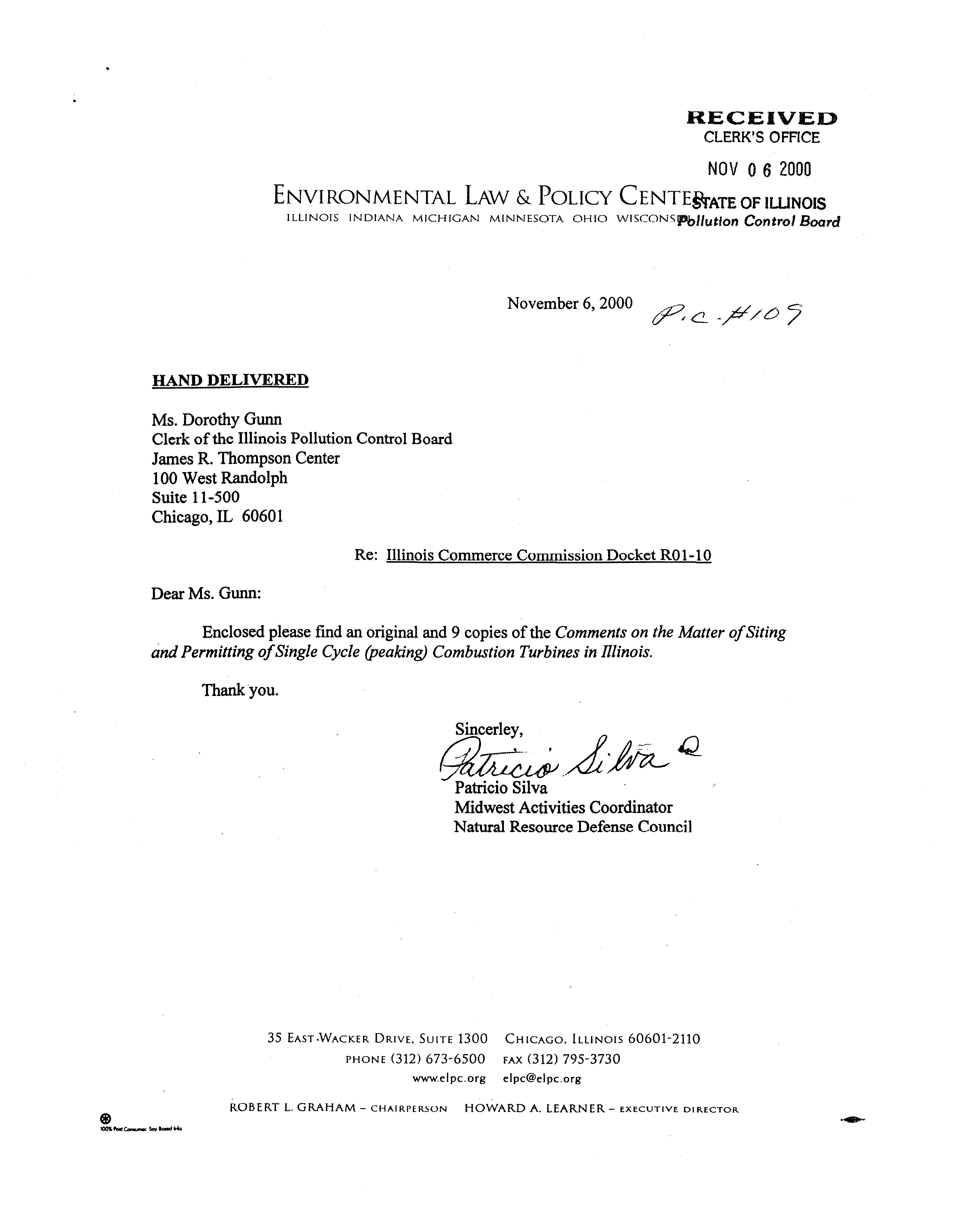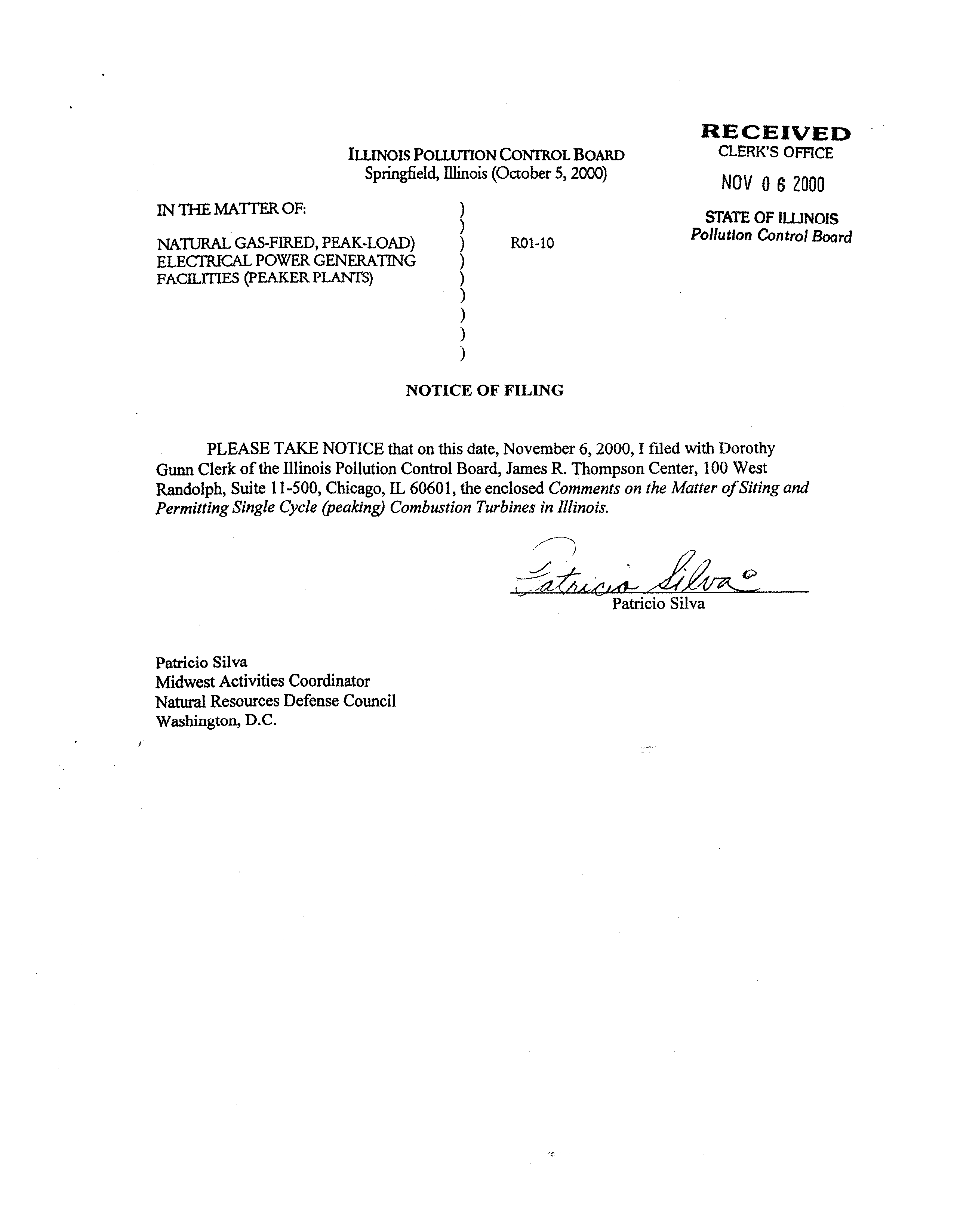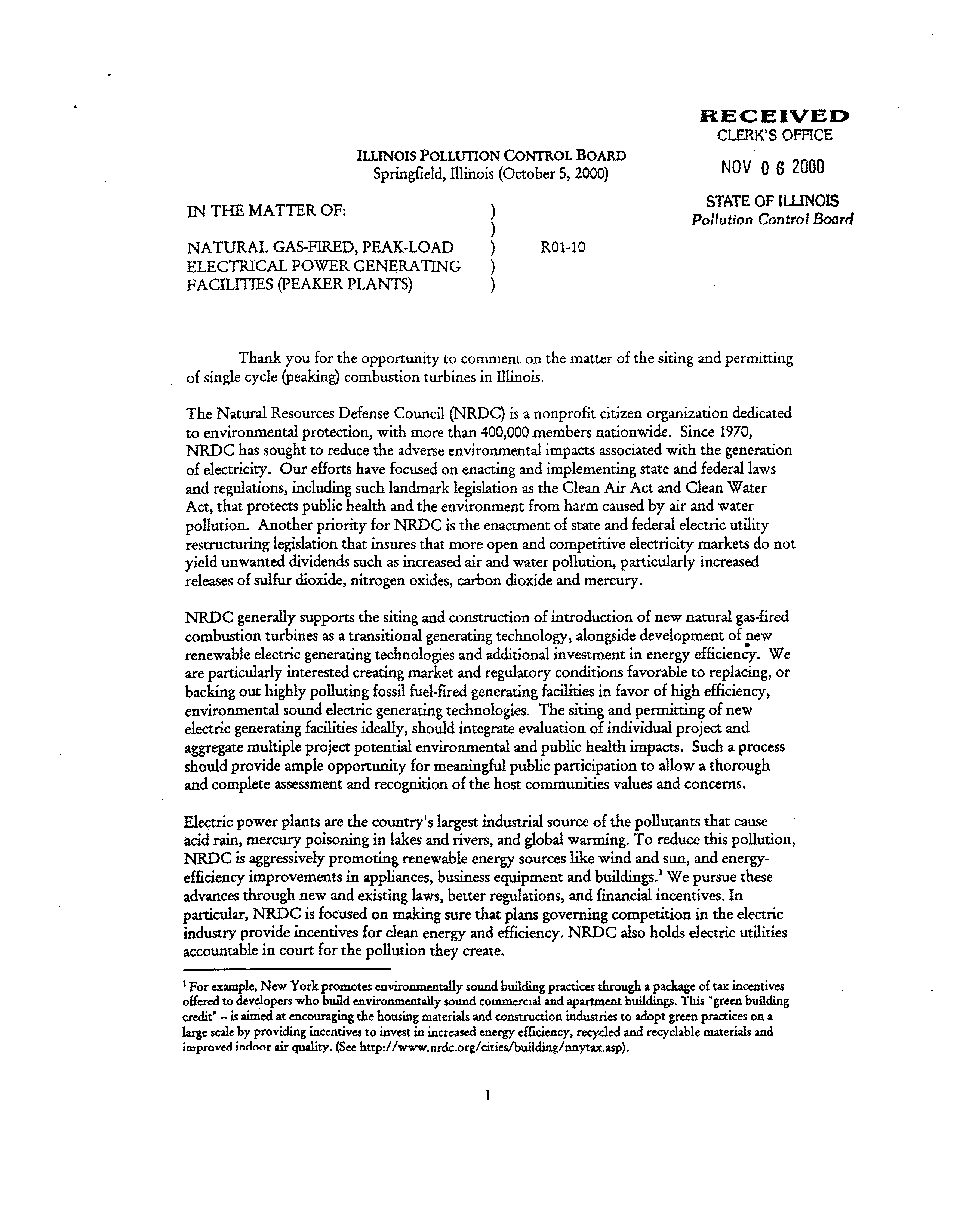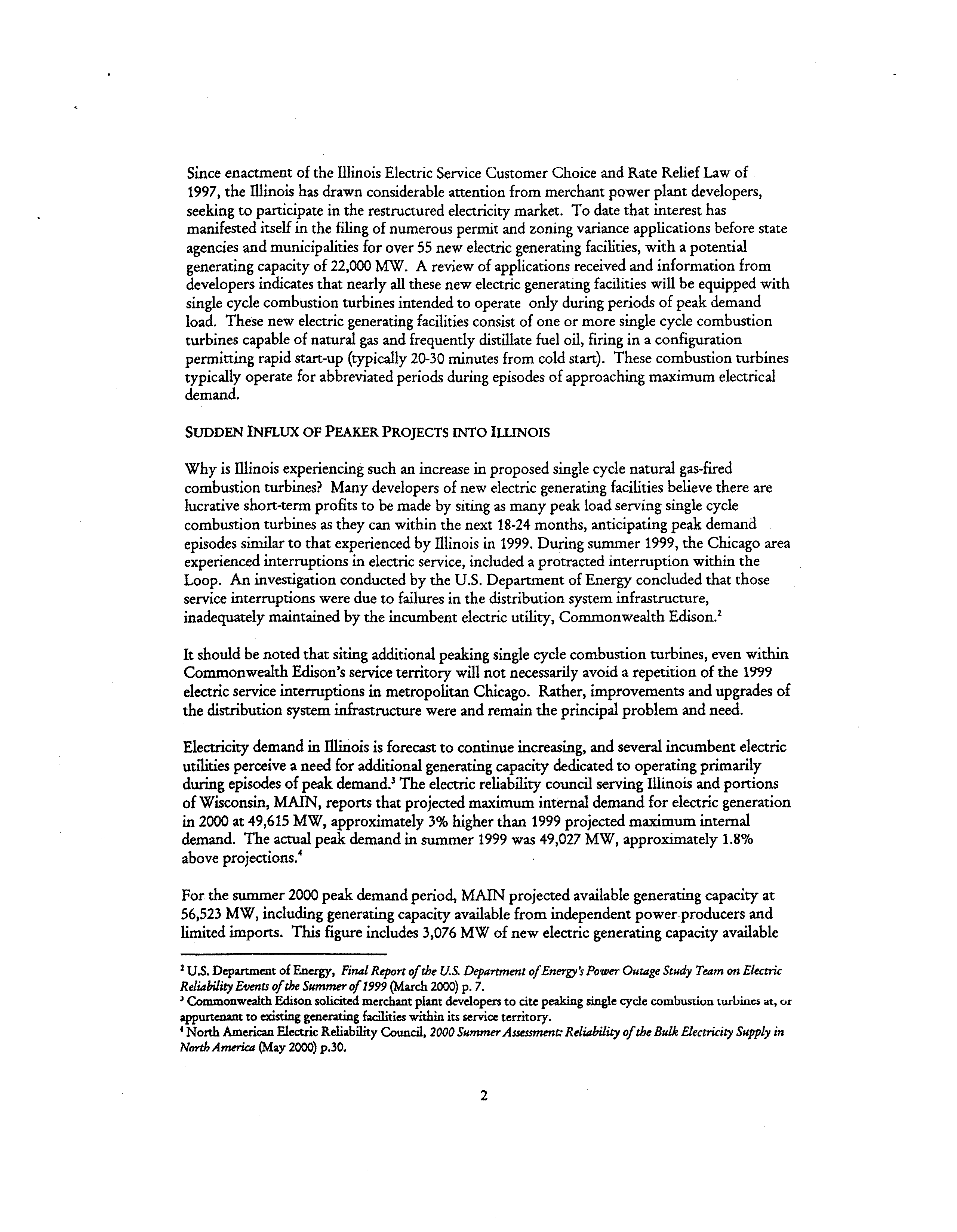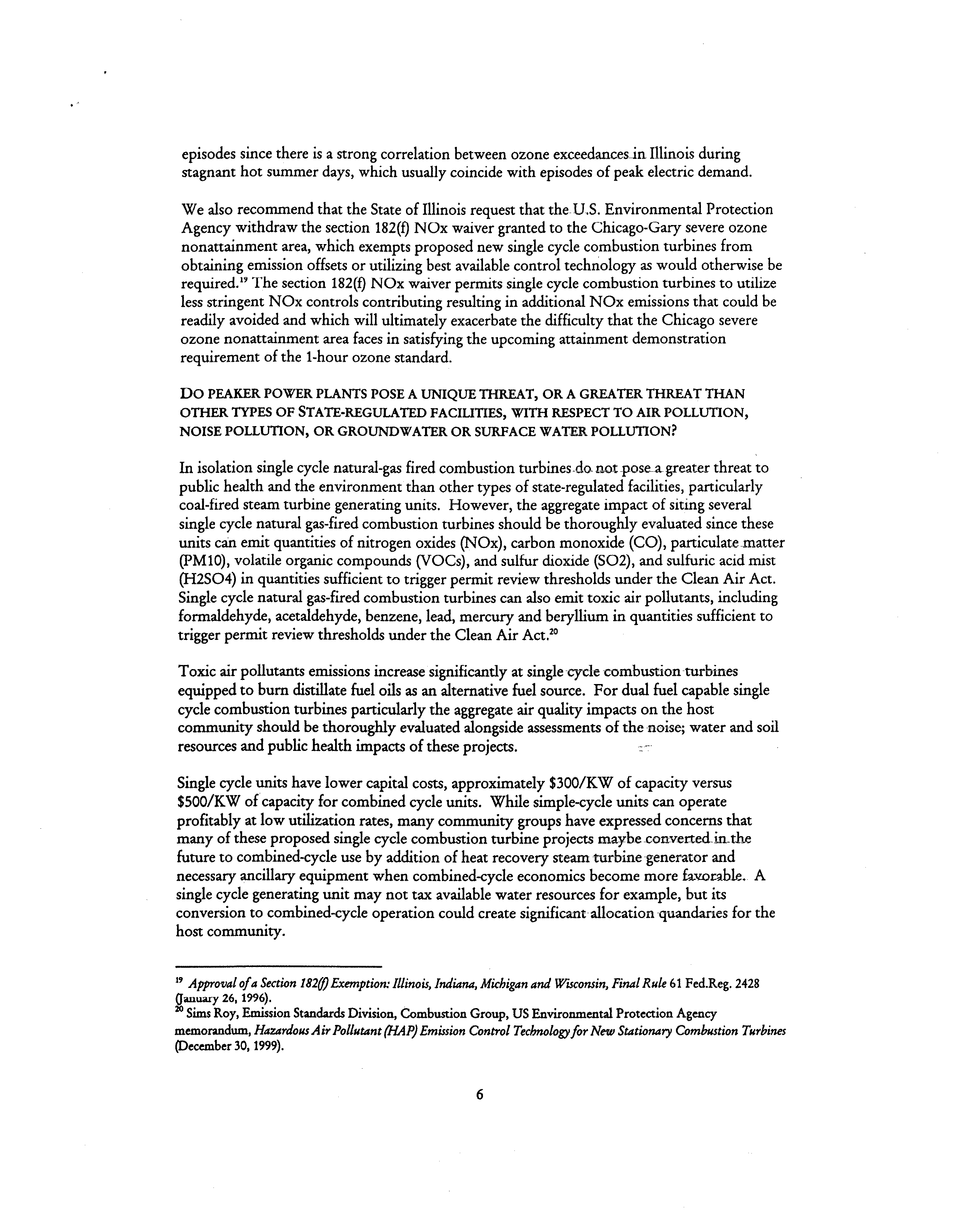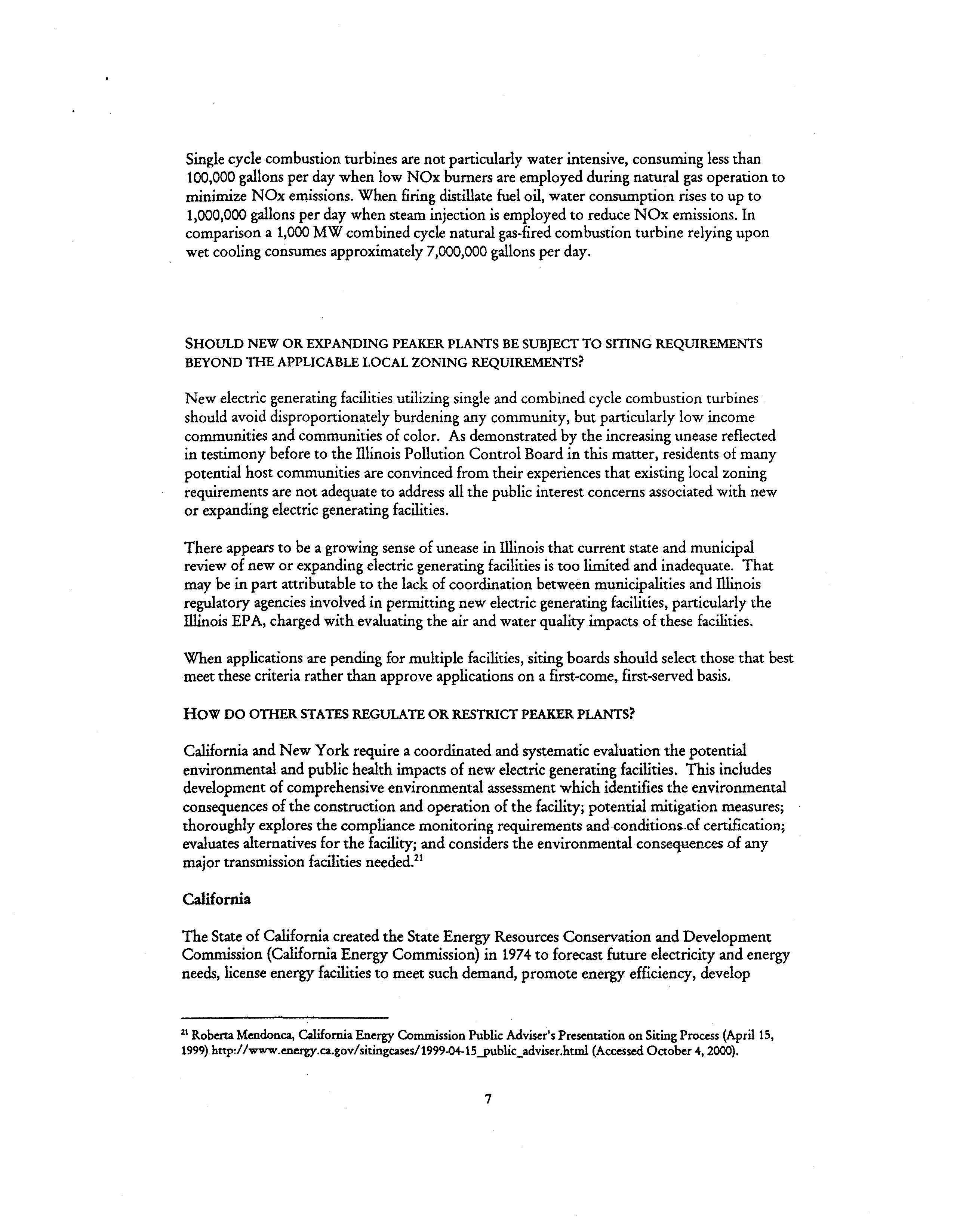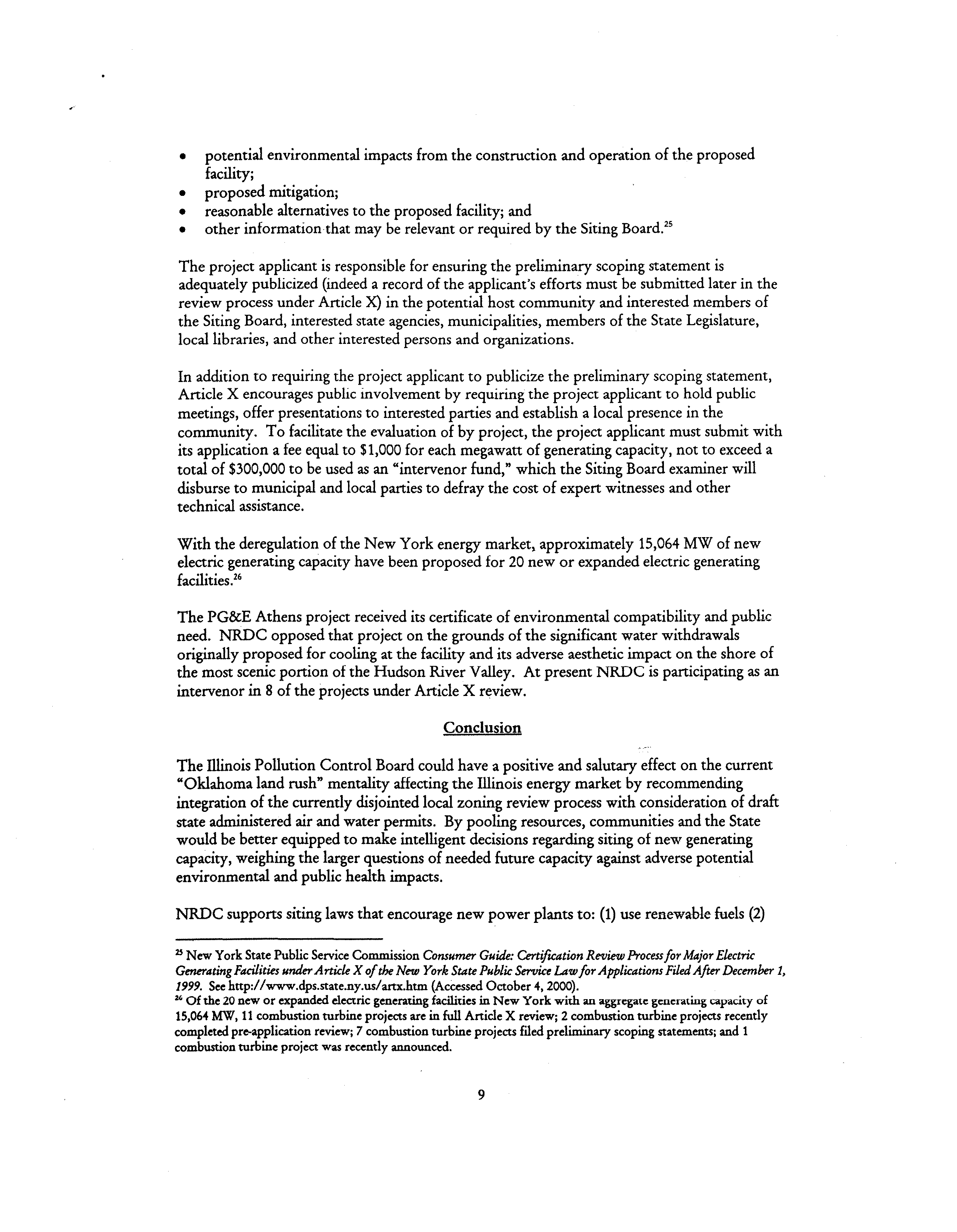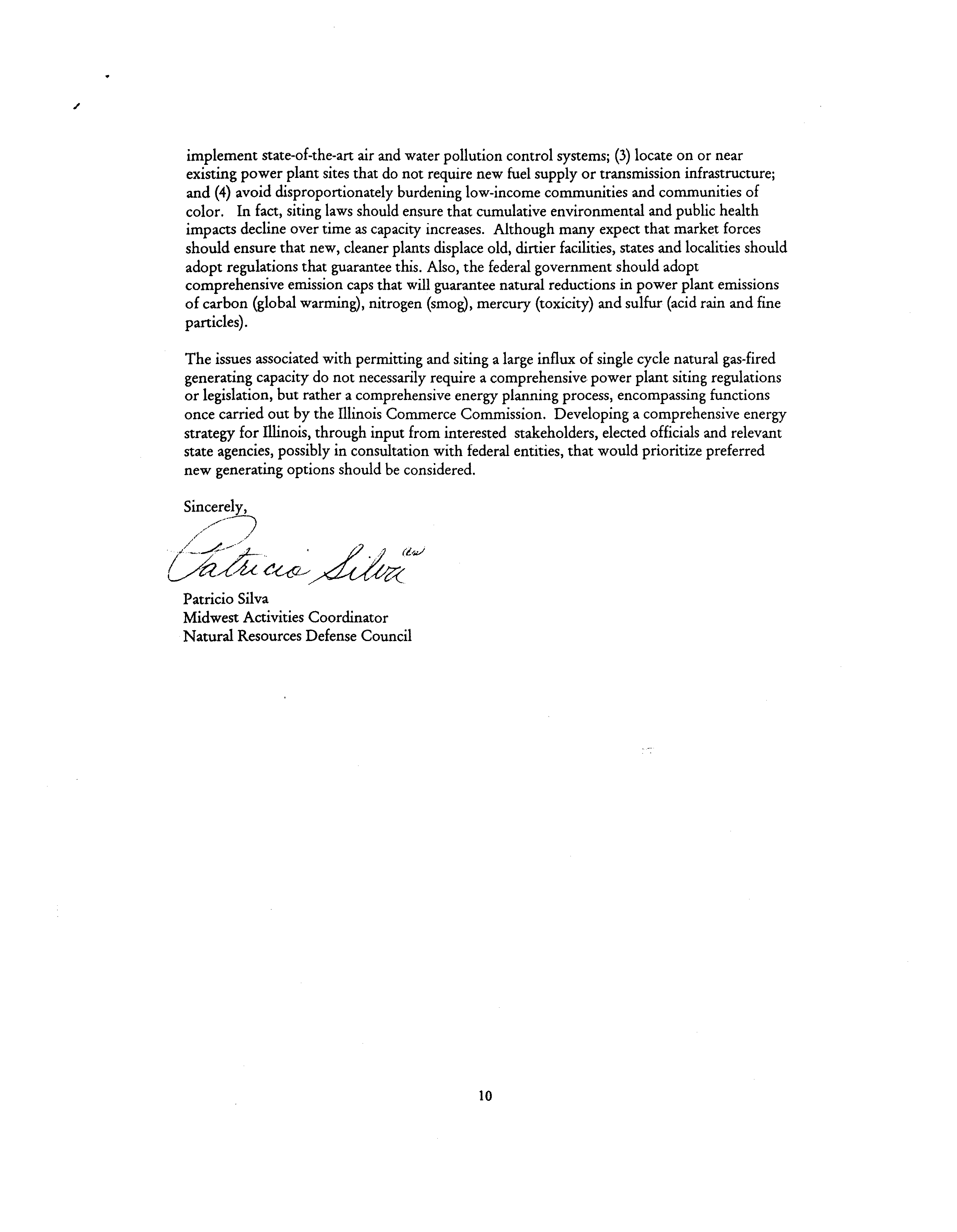RECEiVED
CLERK’S OFFICE
NOV 0 6 2000
ENVIRONMENTAL LAW & POLICY CENTE~FA1EOF1WNOIS
ILLINOIS INDIANA MICHIGAN MINNESOTA
OHIO WISCONS~IIutjofl
Contro! Board
November 6, 2000
HAND DELIVERED
Ms. Dorothy
Gunn
Clerk ofthe Illinois Pollution Control Board
James R. Thompson Center
100 West Randolph
Suite 11-500
Chicago, IL 60601
Re: Illinois Commerce Commission Docket RO 1-10
Dear Ms. Gunn:
Enclosed please fmd an original and 9 copies ofthe
Comments on the Matter ofSiting
and Permitting ofSingle Cycle (peaking) Combustion Turbines in Illinois.
Thank you.
SincerleY~,IQ
Patricio Silva
Midwest Activities Coordinator
Natural Resource Defense Council
35
EAST.WACKER DRIVE, SUITE 1300
CHICAGO, ILLINOIS 60601-2110
PHONE (312) 673-6500
FAX (312) 795-3730
www.elpc.org
eIpc@e~pcorg
ROBERT L. GRAHAM
-
CHAIRPERSON
HOWARD A. LEARNER
-
EXECUTiVE DIRECTOR
IN THE MATTER OF:
ILLINOIS
POLLUTION CONTROL BOARD
Springfield, illinois (October 5, 2000)
NATURAL GAS-FIRED, PEAK-LOAD)
ELECFRJCAL POWER GENERATING
FACILITIES (PEAKER PLANTS)
NOTICE OF FILING
RECEIVED
CLERK’S OFFICE
NOV 0 6 2000
STATE OF IWNOIS
Pollution Control Board
PLEASE TAKE NOTICE that on this date, November 6, 2000, I filed with Dorothy
Gunn Clerk of the Illinois Pollution Control Board, James R. Thompson Center, 100 West
Randolph, Suite 11-500, Chicago, IL 60601, the enclosed
Comments on the Matter ofSiting and
Permitting Single Cycle (peaking) Combustion Turbines in Illinois.
Patricio Silva
Midwest Activities Coordinator
Natural Resources Defense Council
Washington, D.C.
~PatricioSilva
ROl-lO
)
)
)
)
)
)
)
)
)
RECEIVED
CLERK’S OFFICE
ILLINOIS POLLUTION CONTROL BOARD
Springfield, Illinois (October 5, 2000)
NOV 0 6 2000
IN THE
M
A
TTER
OF
.
)
PollutionSTATE
OFControl
ILLINOIS
Board
NATURAL
GAS-FIRED, PEAK-LOAD
)
ROl-lO
ELECTRICAL POWER GENERATING
)
FACILITIES (PEAKER PLANTS)
)
Thank you for the opportunity to comment on the matter of the siting and permitting
of single cycle (peaking) combustion turbines in illinois.
The Natural Resources Defense Council (NRDC) is a nonprofit citizen organization dedicated
to environmental protection, with more than 400,000 members nationwide. Since 1970,
NRDC has sought to reduce the adverse environmental impacts associated with the generation
of electricity. Our efforts have focused on enacting and implementing state and federal laws
and regulations, includingsuch landmark legislation as the Clean Air Act and Clean Water
Act, that protects public health and the environment from harm caused by air and water
pollution. Another priority for NRDC is the enactment of state and federal electric utility
restructuring legislation that insures that more open and competitive electricity markets do not
yield unwanted
dividends such as increased air and water pollution, particularly increased
releases of sulfur
dioxide, nitrogen oxides, carbon dioxide and mercury.
NRDC generally supports
the siting
and construction
of
introduction-of new natural gas-fired
combustion turbines as a transitional generating technology, alongside development of new
renewable electric generating
technologies and additional investment-in-energy efficiency.
We
are particularly interested creating market and regulatory
conditions favorable to replacing, or
backing out highly polluting fossil fuel-fired generating facilities in favor of high efficiency,
environmental
sound
electric generating
technologies.
The siting and permitting of new
electric generating facilities ideally,
should integrate evaluationof individual project and
aggregate multiple project potential environmental and public health impacts. Such a process
should provide ample opportunity for meaningful public participation to allow a thorough
and
complete assessment
and
recognition of the host communities values and concerns.
Electric
power
plants
are the country’s largest
industrial
source of the pollutants that cause
acid rain, mercury poisoning in
lakes and
rivers, and global warming. To reduce
this
pollution,
NRDC
is aggressively promoting renewable energy sources
like
wind and sun, and energy-
efficiency improvements in appliances, business
equipment and buildings.’ We
pursue these
advances through new and existing laws, better regulations, and financial incentives. In
particular, NRDC
is focused on
making sure that plans governing competition in the electric
industry
provide incentives for dean energy and efficiency.
NRDC also
holds electric utilities
accountable in
court
for
the
pollution they create.
‘For example, New York promotes environmentallysound building practices through a package of tax incentives
offered to developers who build environmentallysound commercial and apartmentbuildings. This “green building
credit”
-
is aimed at encouraging the housing materialsand construction industries
to
adopt green practices on a
large scale by providing incentives to invest in increased energy efficiency, recycled and recydable materials and
improved indoor air quality. (See http://www.nrdc.org/cities/building/unytax.asp).
Since enactment of the illinois Electric Service Customer Choice and Rate Relief Law of
1997, the Illinois has drawn considerable attention from merchant power plant developers,
seeking to participate in the restructured electricity market. To date that interest has
manifested itself in the filing of numerous permit and zoning variance applications before state
agencies and municipalities for over 55 new electric generating facilities, with a potential
generating capacity of 22,000 MW. A review of applications received and information from
developers indicates that nearly all these new electric generating facilities will be equipped with
single cycle combustion turbines intended to operate only during periods of peak demand
load. These new electric generating facilities consist of one or more single cycle combustion
turbines capable of natural gas and frequently distillate fuel oil, firing in a configuration
permitting rapid start-up (typically 20-30 minutes from cold start). These combustion turbines
typically operate forabbreviated periods during episodes of approaching maximum electrical
demand.
SUDDEN INFLUX OF PEAKER
PROJECTS
INTO ILLINoIs
Why is Illinois experiencing such an increase in proposed single cycle natural gas-fired
combustion turbines? Many developers of new electric generating facilities believe there are
lucrativeshort-term profits to be made by siting as many peak load serving single cycle
combustion turbines as they can within the next
18-24
months, anticipating peak demand
episodes similar to that experienced by Illinois in 1999. During summer 1999, the Chicago area
experienced interruptions in electric service, included a protracted interruption within the
Loop. An investigation conducted by the U.S. Department of Energy concluded that those
service interruptions were due to failures in the distribution system infrastructure,
inadequately
It should be noted
maintained
that siting
by
theadditionalincumbentpeakingelectricsingleutility,cycleCommonwealthcombustion
turbines,
Edison.
even
2
within
Commonwealth Edison’s service territory will not necessarily avoid a repetition of the 1999
electric service interruptions in metropolitan Chicago. Rather, improvements andupgrades of
the distribution system infrastructure were and remain the principal problem andneed.
Electricity demand in illinois is forecast to continue increasing, andseveral incumbent electric
utilities perceive a need for additional generating capacity dedicated to operating primarily
during episodes of peak demand.3 The electric reliability council serving Illinois and portions
of Wisconsin, MAIN, reports that projected maximum internal demand for electric generation
in 2000 at 49,615 MW, approximately 3 higher than 1999 projected maximum internal
demand. The actual peak demand in summer 1999 was 49,027 MW, approximately 1.8
aboveFor
the
projections.
summer 2000
4
peak demand period, MAIN projected available generating capacity at
56,523
MW, including generating capacity available from independent power producers and
limited imports. This figure includes 3,076 MW of new electric generating capacity available
2U.S. Department of Energy,
FinalReport
of
the U.S. Department
of
Enerzj~sPower
Outage
Study Team on Electric
ReliabilityEvents
of
the Summer
of1999
(March 2000) p.7.
Commonwealth Edison solicited merchant plant developers
to cite
peaking single cycle combustion turbines at, or
appurtenant to existing generating facilities within its service territory.
4North American Electric Reliability Council,
2000SummerAsussment Reliability
ofthe Bulk
Electricity Supply in
North America
(May 2000) p.30.
2
for dispatch, representing 11 new generating facilities, upgrades at existing generating facilities
and temporary facilities.’
The experience of Illinois is not unique. Electricity demand is expected to continue growing
rapidly for the foreseeable future, requiring significant construction of additional electric
generating capacity, especially if downward trends in energy efficiency and demand-side
management investments continue in the United States. The Energy Information
Adntinistration
(EIA) forecasts that by 2020, an additional 300 gigawatts of electric generating
capacity will be required to satisfy increasing domestic energy demand
and replace retired fossil
fuel-firedand nuclear generating units.6
Even under their most conservative forecast scenarios
“gas technologies are expected to dominate new generating capacity-additions.”7 EIA predicts
that 90 will be combustion turbine technology,8 with additions of combined cycle generating
capacity being the fastest growing segment of the electric power industry through 2020.~Other
independent forecasters predict increases of similar magnitude, all relying upon natural gas
consumption to fuel much of that new electric generating capacity.
10
Much of this new natural
gas-fired generating capacity is expected well before 2020 with
EIA~s
short-term forecast predicting nearly 100
gigawatts by 2010, while other forecasters suggesting
up to 180 gigawatts by 2010. All forecasts do agree that the majority of thisnew generating
capacity will be either single or combined cycle natural gas-fired combustion turbines, with
combined
Illinois is experiencing
cycle units augmented
the leading
with
edge
heat-recovery
of an energy
steam
“Oklahoma
generators.
land
11
rush” phenomenon that
has
already played itself out
in New England, where energy markets were deregulated earlier
than in Illinois. By early 1999 some 63 electric generating projects were proposed in New
England, totaling 31,000 MW of generating capacity, of which between 7,000 and 8,000 MW
are expected to actually be built.12 By way of comparison, the current annual peak demand in
New England is approximately 22,544 MW with the New England Independent
System
Operator (ISO) calculating that an additional 4,000 MW of generating capacity is all that is
required to meet short term expected increases in electric demand.
The 31,000 MW of generating capacity originally
proposed in New England
was winnowed
down to approximately 9,437 MW by power plant siting authorities and-environmental
regulatory agencies in Massachusetts, Maine, New Hampshire, Connecticut, and Rhode Island.
Most relevant is that of the 36 combustion turbines being permitted at 19 electric generating
Id. p.30-31. Approximately 60 of the new generating capacity is owned by iudcpc~idcutpower producers.
MAIN predicted 2,223 MW would “be available by June 1, an additional 600 MWby July 1, and the balance by
August 1.” p. 31.
‘Energy Information Administration,
Annual Energy Outlook 2000
DOE/EIA-0383(2000), p. 65. EIA forecaststhat
90 percent of new capacityis projected to be combined-cyde or combustion turbine technology fueled by natural
gas or both oil and gas. In comparison, 21 gigawatts (or 7 percent) of new capacity is expectedto be new coal-fired
capacity.
7Encrgy Information Administration,
Annual Energy Outlook 2000
DOE/EIA-0383(2000), p.
65.
~I~pp. 64-71.
‘Energy InformationAdministration,
Annual Energy Outlook
2000
DOE/EIA-0383(2000) Appendix A, Reference
Case Forecast,
Table
9.
~
p.97 (comparing natural gas forecasts of EIA, WEFA, Gas Research Institute, and Standard & Poo?s DRI),
11Gas Turbines, Combined Cydes Harvest Record Orders,”
Power
(Mardi/April 2000) p. 30; “Merchant Power
Projects Push for Competitive Edge,”
Power
(January/February 2000) p. 32.
t2CarlJ. Levesque, “Merchant Plants, Coast to Coast”
Public
Utilities Fortnightly
(January 1, 1999) p. 26.
3
These
facilities
combustion
across New
turbines
England,
are
~fl
expected
are combined
to operate
cycleasnaturalintermediategas-firedloadcombustionfollowing turbines.or
base load13
units, rather than peaking units.
In the neighboring state of New York, 20 new electric generating facilities are undergoing
siting review representing a total of 15,064 MW of generating capacity, available information
indicates they will be equipped with combined cycle combustion turbines (See discussion
below on New York siting process for additional details).
RECENT TURMOIL
IN
THE CALIFORNIA ENERGY MARKETS
The electric generating facility siting review process administered by the California Energy
Commission has been the subject of earlier testimony addressing only the recent reliability
concerns in California. We offer a broader perspective on the matter. The conventional
wisdom is that electricity consumption in California is surging out of control; “the Internet”
and a booming economy often are frequently invoked as explanations. In fact, the California
system peak from 1990-1999 grew less than 2 per year (to about 50,000 MW, with 41,000
MW representing total demand on the three large investor-owned systems).14 Total statewide
consumption of electricity increased less than 1 per year from 1990-1998 (less than one third
the rate of the 198Os). Recent data indicate significant short-term consumption increased over
the first six months of 2000 compared to the same period a year earlier, with much warmer
weather playing astrong role.
Electricity use spiked in June 2000, up almost 13 compared to the much cooler June of a year
earlier.15 This clearly contributed to sharply higher wholesale electricity prices for June 2000,
which averaged about twelve cents per kilowatt-hour (a sixfold increase over the June
1999
figure). It didn’t help, obviously, that natural gas prices also were soaring above five dollars
per millionBtu (if sustained, this would drive the fuel costs alone for older gas-fired power
plants past five cents per kWh produced). The first three weeks of July saw more moderate
weather in California, and both electricity andpeak consumption were down compared to the
same period a year earlier; average wholesale electricity prices-dropped-about 40.
However,
atmore than seven cents per kWh, these prices were still very high by recent historical
standards, and more unpleasant surprises are entirely possible in the months ahead.
The short term reliability crisis in California should be quickly and cost-effectively resolved by
additional investment and deploymentof energy efficiencyand renewable energy on
sufficiently large scale, alongside entry into service of single and combined cycle natural-gas-
fired combustion turbines already in the siting and construction process (more than 3500 MW
already having completed the siting process).
The deployment of energyefficiency and renewable energy investments have already made
significant contributions to California’s economy and electricity grid. California’s efficiency
programs and standards have reduced peak electricity demand by 10,000 MW and total annual
“US
Environmental
Protection Agency Region 4, “National
Combustion
Turbine List,”
provided
on
August
16,
2000.
This
is most up-to-date index available, but has not undergone full agency review nor is it
likely
current for
activity
in other
EPA
regions,
and
therefore
likely understates
total number ofcombustion projects.
‘4California Energy Commission,
California EnergyDeinanth 2000.2010
(June 2000). See
http://www.energy.ca.gov for
additional
information.
‘8California Independent
System Operator,
MarketAnalysisReport
(July
24, 2000).
4
consumption has been reduced by approximately
15.
Since 1990, energy efficiency
investments have reduced statewide electric bills by more than $2.8
billion. As a result,
“California continues to lead the nation in maximizing the amount
of Gross State Product
produced per
unit of energy.”16 The RAND Corporation has pegged per capita benefits from
twenty years of energy efficiency programs in
California
at about
$1,000 per capita, with
cumulative utility investment for such purposes averaging only about $125 per capita.17 This
and other independent reviews agree that California still has numerous untapped and
inexpensive opportunities to get more work out of less electricity.
Renewable energy is also a critical part of California’s energy portfolio, with about one-ninth
of the state’s supply now generated from wind, solar, geothermal or biomass resources.
Thanks to a 1998 auction for new renewable capacity, more than 500 MW of urgently needed
supply are now being added to the California system, with almost 100 MW already installed,
more than 400 MW expected by the end of 2001, and at least 900 additional MW available for
near-term purchase. The new capacity has gratifyingly short lead-times, with the 50 winning
bidders all scheduled to be operating by summer of 2002.
We turn now to the questions posed to the fllinois Pollution Control Board by Governor
Ryan in his August 6, 2000 letter requesting this proceeding.
DO
PEAKER PLANTS NEED
TO BE
REGULATED MORE STRICTLY THAN ILLINOIS’ CURRENT
AIR
QUALITY STATUTES
AND
REGULATIONS
PRO
VIDE?
Natural
gas-fired combustion turbines represent the best available large-scale fossil fuel
generation in terms of minimal adverse air quality impacts. Combustion turbines, particularly
combined cycle applications are capable of obtaining 55-60 efficiencies and with best
available pollution control technology to
mimizie emissions of nitrogen oxides (NOx), carbon
monoxide (CO), particulate matter (PM1O), volatile
organic compounds (VOCs), and sulfur
dioxide (S02).
Single cycle natural gas-fired combustion turbines are considerably less efficient,
operating between 28-35 with combustion controls limiting NOx emissions to 15-25 ppm.
The national
permitting
data for combustion turbine projects compiled by EPA Region 4
identified indicates new electric generating facilities representing over 750 -combustion turbines
were in state
or federal Clean
Air Act permitting
between 1998
andJuly 2000, with a projected
generating capacity of 53,000
MW.’8 Of
that total 340 combustion turbines
were single cycle
units, the actual figure may be significantly overstated since the
figures represent permitted,
not constructed combustion turbines. Developers frequently seek necessary air, water permits
and
zoning variances
for multiple sites, but only build on the proposed electric generating
facility on whichever site is the first to obtain
all the necessary approvals.
While
single cycle natural gas-fired combustion turbines can achieve 15-25 ppm with limited
combustion controls, the aggregate impact of the proposed combustion turbine projects in
Illinois would
amount
to several
hundred
tons,
likely
to be emitted during the worst ozone
California Energy Commission,
The Energy EfficiencyPublic Goods Charge Report,
p.12
(December
1999);
dataon
net benefits are from NRDC,
Investments in thePublic Interest
(January
2000).
“RAND,
The Public Benefits of California’s Investmeius in Energy Efficiency,
p.
xiv (March 2000).
ISUS
Environmental Protection Agency Region
4,
~NationalCombustion Turbine List,’ providedon August
16,
2000. This is most up-to-date index available,
but
has not undergone full agency reviewnor is
it
likely current for
activity in other EPA regions, and therefore likely understates total number of combustion projects.
5
episodes since there is a strong correlation between ozone
exceedancesin Illiaois during
stagnant hot summer days, which usually coincide with episodes of peak electric demand.
We also recommend that the State of Illinois request that the U.S. Environmental Protection
Agency withdraw the section 182(f)
NOx
waiver granted to the Chicago-Gary severe ozone
nonattainment area, which exempts proposed new
single cycle combustion turbines from
obtaining emission offsets or utilizing best available control technology as would otherwise be
required.”
The section 182(1)
NOx waiver permits single cycle combustion turbines to utilize
less stringent NOx controls contributing resulting in additional NOx emissions that could
be
readily avoided and which will ultimately exacerbate the difficulty that the Chicago severe
ozone
nonattainment area faces in satisfying the upcoming attainment demonstration
requirement of the 1-hour ozone standard.
DO
PEAKER POWER PLANTS
POSE A
UNIQUE THREAT,
OR A
GREATER THREAT THAN
OTHERTYPES
OF
STATE-REGULATEDFACILITIES, WITH RESPECT
TO AIR POLLUTION,
NOISE POLLUTION, OR GROUNDWATER OR SURFACE WATER POLLUTION?
In isolation single cycle natural-gas fired combustion turbines do. not posea greater threat to
public health and the environment than other types of state-regulated facilities, particularly
coal-fired steam turbine generating units. However, the aggregate impact of siting several
single cycle natural gas-fired combustion turbines should be
thoroughly evaluated since these
units can emit quantities of nitrogen oxides (NOx), carbon monoxide (CO), particulate -matter
(PM1O), volatile
organic compounds (VOCs), and sulfur
dioxide
(S02),
and sulfuric acid mist
(H2S04) in quantities sufficient to trigger permit review thresholds under the Clean Air Act.
Single cycle natural gas-fired combustion turbines can also emit
toxic air pollutants, including
formaldehyde, acetaldehyde, benzene, lead, mercury and beryllium in quantities sufficient to
trigger permit review thresholds under the Clean Air Act.2°
Toxic air pollutants emissions increase significantly at single-cyclecombustion-turbines
equipped
to burn
distillate
fuel oils as an
alternative fuel
source. For dual fuel capable single
cycle combustion turbines particularly the aggregate air
quality impacts
on the host
community should
be thoroughly evaluated alongside assessments of the -noise; water and soil
resources and public health impacts of these projects.
-: -~
Single cycle units have lower capital costs, approximately $300/KW of capacity versus
$500/KW of capacity for combined cycle units. While simple-cycle units can operate
profitably at low utilization rates, many
community
groups have expressed concerns that
many of these proposed single cycle combustion turbine projects maybe
convertedinthe
future to combined-cycle use by addition of heat recovery steam -turbine -generator and
necessary ancillary equipment when combined-cycle economics become more favorabk. A
single cycle generating
unit
may not
tax
available water resources for example, but
its
conversion to combined-cycle operation could create significant-allocation
-quandaries
for the
host community.
19
Approval
ofa Section 182(1)
Exemption.. Illinois, Indiana, Michigan and Wisconsin, FinalRule
61 Fed.Reg. 2428
(January
26,
1996).
20Sims Roy, Emission Standards Division, Combustion Group, US Environmental ProtectionAgency
memorandum,
HazardousAirPollutant(HAP)Emission
Control Technology
for
New Stationary Combustion Turbines
(December 30,
1999).
6
Single cycle combustion turbines are not particularly water intensive, consuming less than
100,000
gallons per
day
when low NOx burners are employed during natural gas operation to
minimize NOx emissions. When firing distillate fuel oil,
water consumption rises to up to
1,000,000
gallons per day when steam injection is employed to reduce
NOx emissions. In
comparison a
1,000
MW combined cycle natural gas-fired combustion turbine relying upon
wet cooling consumes approximately 7,000,000 gallons per day.
SHOULD NEW OR EXPANDING
PEAKER
PLANTS BE SUBJECT TO SITING
REQUIREMENTS
BEYOND
THE
APPLICABLE LOCAL ZONING
REQUIREMENTS?
New electric generating facilities utilizing single and combined cycle combustion turbines
should avoid disproportionately burdening any community, but particularly iow income
communities and communities of color. As demonstrated by the increasing unease reflected
in testimony before to the Illinois
Pollution Control Board in
this matter, residents of many
potential host communities are convinced from their experiences that existing local zoning
requirements are not adequate to address all the public interest concerns associated with new
or expanding electric generating facilities.
There
appears to be a growing sense of unease in
Illinois that current state and municipal
review of new or expanding electric generating facilities is too limited and inadequate. That
may be in part attributable to the lack of coordination between municipalities
and Illinois
regulatory agencies involved in permitting new electric generating facilities, particularly the
Illinois
EPA, charged with evaluating the
air and water quality impacts of these facilities.
When applications are pending for multiple facilities, siting boards should select those that best
meet these criteria rather than approve applications on a
first-come, first-served basis.
How DO
OTHER STATES REGULATE
OR
RESTRICT PEAKER PLANTS?
California
and New York require a coordinated
and systematic evaluation the potential
environmental and
public
health impacts of
new electric generating facilities.
This
includes
development of comprehensive environmental assessment
which identifies the environmental
consequences of the construction and operation of the facility; potential mitigation measures;
-
thoroughly explores the compliance monitoring requirements-and
-c-onditions-of-certification
evaluates alternatives for the facility; and considers the environmental-consequences of any
major
transmission facilities needed.2’
California
The State of
California
created the
State Energy Resources
Conservation and Development
Commission (California
Energy
Commission) in 1974 to
forecast future electricity and energy
needs, license energy facilities to meet such demand, promote energy efficiency, develop
2tRoberta Mendonca, CaliforniaEnergy Commission Public Adviser’s Presentation on Siting Process (April 15,
1999) http~//wwwenergy.ca.gov/sitingcases/1999-04-15.public adviser.htnil (AccessedOctober 4,2000).
7
renewable energy resources, and planning for and directing state responses to energy
emergencieS.n
The California energy facilities siting process is particularly rigorous, requiring demonstration
of need, balanced against the potential environmental and public health impacts. An applicant
seeking to site a new electric generating facility of 50 MW or greater is required to submit a
pre-application for review by California Energy Commission technical staffto evaluate public
health, environment, electric engineering and system reliability. The California energy
facilities siting process requires a single regulatory permit (insured by simultaneous review of
air, water quality permit requirements be relevant municipal, state and federal regulatory
agencies), decided within a specific time frame, and providing for full participation by public,
interest groups.
The California Legislature amended the energy facilities siting process by establishing a “fast
track” process of 6 months for new electric generating facilities presenting no significant
adverse environmental impacts, with the California Energy Commission granted emergency
regulatory authority to develop the program expeditiously. Under
AB
970, a peaking simple
cycle combustion turbine can obtain a three year operating permit in under 4 months, if they
present no significant adverse environmental impacts and are equipped with best available
control technology. A condition of the threeyear permit is that peaking simple cycle turbine
operator commit to conversion of the combustion turbine to a combined cycle operation
withinSingle
cyclethreenaturalyears
orgas-firedcease operation.combustion23
turbines operating under contract with California
Independent System Operator (ISO) which emit less than 5 ppm (recall that most peakers emit
15-25 ppm NOx with limited controls) and displaces more polluting existing generating
capacity
New York
can obtain expedited air permit approvals.24
The State of New York recently consolidatedthe permitting of new electric generating
capacity greater than
80 MW
under the New York State Board on Electric Generation Siting
and the Environment, under Article X of the New York Public ServiceLaw. Prior to
commencing construction, a power plant developer must obtain a “Certificate of
Environmental Compatability and Public Need” for all projects proposed after December 1,
1999.
The New York State Board on Electric Generation Siting and the Environment is authorized
to issue both air and water permits (CAA Title V permits and CWA State Pollutant Discharge
Elimination System (SPDES)) in collaboration with the New York Department of
Environmental Conservation. Under Article X, the project applicant is required to file a
preliminary scoping statement explaining in detail:
• the proposed facility and its environmental setting;
“
Warrcu-Alquist Act, California Public Rc3ourccs Codc Scction 25000 ct
~cq. For
additional information
on
new
electric generating facility siting in California, see http://www.energy.ca.gov/siting/guide_license~process.html.
~ California Energy Commission,
Cal~fomiaEnergy Legislation Highlights 2000
(October 2000).
241d.
8
• potential environmental impacts from the construction and operation of the proposed
facility;
• proposed mitigation;
•
reasonable alternatives to the proposed facility; and
• other information-that may be relevant or required by the Siting Board.2’
The project applicant is responsible for ensuring the preliminary scoping statement is
adequately publicized (indeed a record of the applicant’s efforts must be submitted later in the
review process under Article X) in the potential host community and interested members of
the Siting Board, interested state agencies, municipalities, members of the State Legislature,
local libraries, and other interested persons and organizations.
In addition to requiring the project applicant to publicize the preliminary scoping statement,
Article X encourages public involvement by requiring the project applicant to hold public
meetings, offer presentations to interested parties and establish a local presence in the
community. To facilitatethe evaluation of by project, the project applicant must submit with
its application a fee equal to $1,000 for each megawatt of generating capacity, not to exceed a
total of $300,000 to be used as an “intervenor fund,” which the Siting Board examiner will
disburse to municipal and local parties to defray the cost of expert witnesses and other
technical assistance.
With the deregulationof the New York energy market~approximately 15,064 MW of new
electric generating capacity have been proposed for 20 new or expanded electric generating
facilities.
The PG&E
26
Athens project received its
certificate of environmental compatibility
and public
need. NRDC opposed that project on the grounds of the significant water withdrawals
originally proposed for cooling at the facility and its
adverse aesthetic impact on
the shore of
the most scenic portion of the Hudson River Valley. At present NRDC is participating as an
intervenor in 8 of the projects under Article X review.
Conclusion
The illinois Pollution Control Board could have a positive and salutary effect on the current
“Oklahoma land rush” mentality affecting the Illinois energy market by recommending
integration of the
currently disjointed local zoning review process with consideration of draft
state administered air
and water permits. By pooling resources, communities and the State
would be better equipped to make intelligent decisions regarding siting
of new
generating
capacity, weighing the larger questions of needed future capacity against adverse potential
environmental and public
health impacts.
NRDC
supports siting laws that encourage new power plants to: (1) use renewable fuels (2)
2S
New
York State
Public Service Commission
Consumer Guide: Cert~cationReview ProcessforMajorElectric
GeneratingFacilities underArticle
X
of the New York State Public Service LawforApplicationsFiledAfter December1,
1999.
See
http://www.dps.state.ay.us/artx.htm (Accessed
October4,
2000).
~‘ Of
the
20
new or
expanded
electric generating facilities in
New York with an aggregate
generating capacity
of
15,064 MW, 11
combustion turbine projects are in full Artide X review;
2
combustion turbine projects recently
completed pre-application review; 7 combustion turbine projects filed preliminary scoping statements; and
I
combustion turbine
project
was recently announced.
9
1
implement state-of-the-art air and water pollution control systems; (3) locate on or near
existing power plant sites that do not require new fuel supply or transmission infrastructure;
and (4) avoid disproportionately burdening low-income communities and communities of
color. In fact, siting laws should ensure that cumulative environmental and public health
impacts decline over time as capacity increases. Although many expect that market forces
should ensure that new, cleaner plants displace old, dirtier facilities, states and localities should
adopt regulations that guarantee this. Also, the federal government should adopt
comprehensive emission caps that will guarantee natural reductions in power plant emissions
of carbon (global warming), nitrogen (smog), mercury (toxicity) and suifur (acidrain and fine
particles).
The issues associated with permitting and siting a large influx of single cycle natural gas-fired
generating capacity do not necessarily require a comprehensive power plant siting regulations
or legislation, but rather a comprehensive energy planning process, encompassing functions
once carried out by the Illinois Commerce Commission. Developing a comprehensive energy
strategy for illinois, through input from interested stakeholders, elected officials and relevant
state agencies, possibly in consultation with federal entities, that would prioritize preferred
new generating options should be considered.
Sincerely,
/
--~
Patricio Silva
Midwest Activities Coordinator
Natural Resources Defense Council
10


